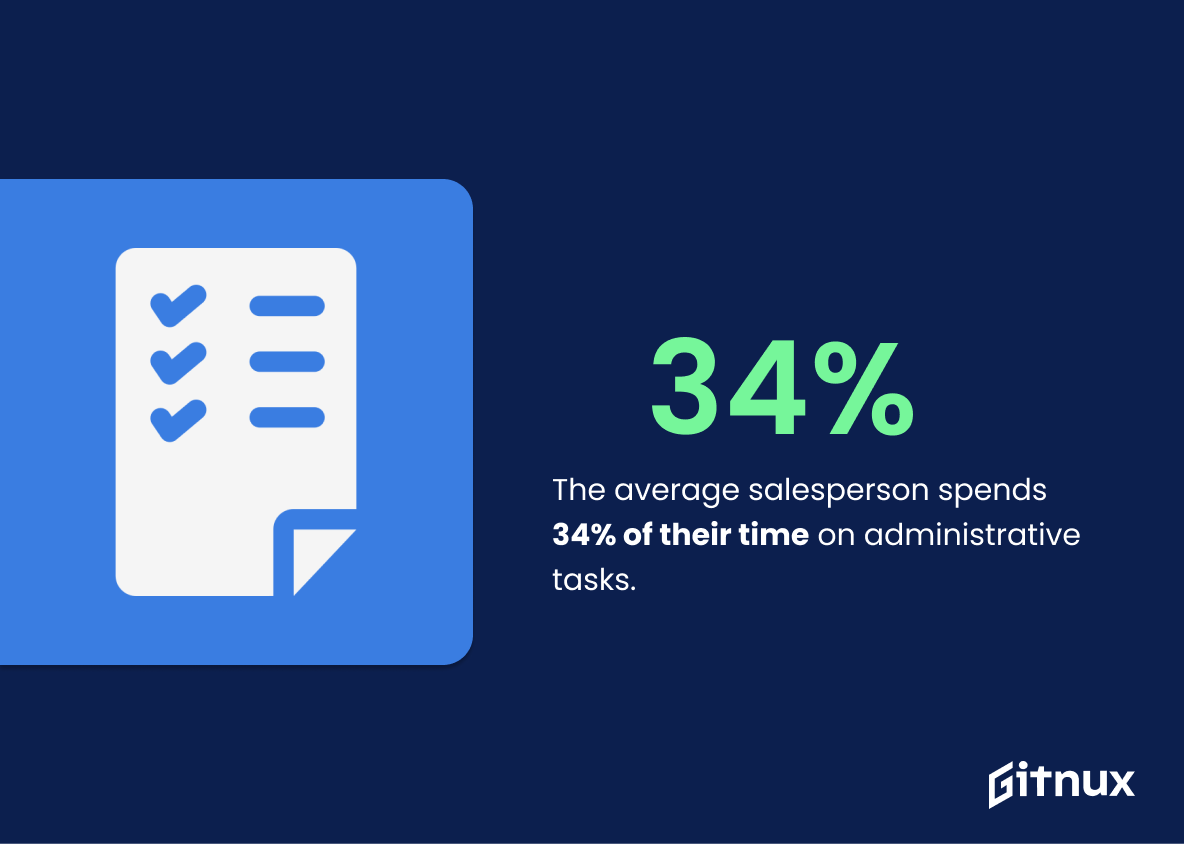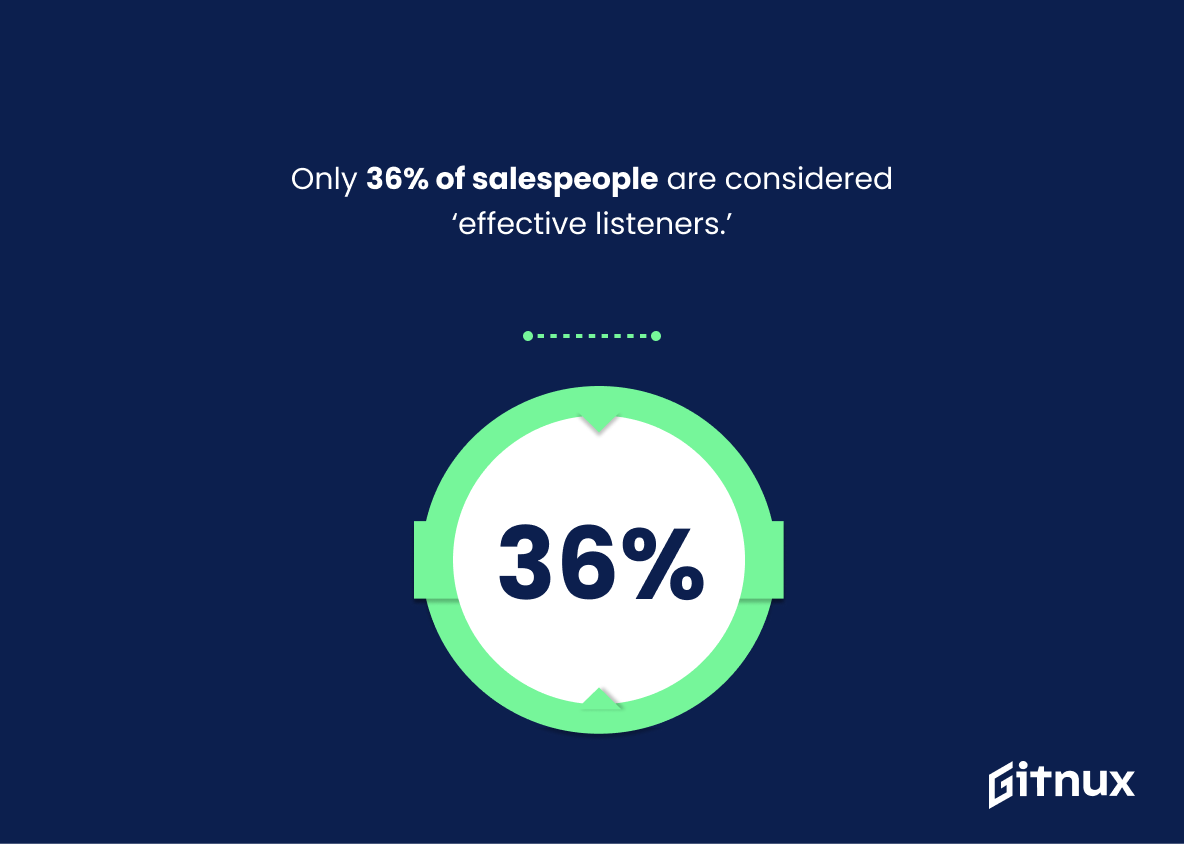The sales industry is constantly evolving, and it’s important to stay up-to-date on the latest trends. To help you do that, here are 20 statistics about salespeople from 2020: 46% of them met or exceeded their quota; 57% believe developing buyer relationships is vital to success; only 39% of a salesperson’s time was spent actually selling in 2020; approximately 13% of all US jobs are full-time sales positions; the average salesperson spends 34% of their time on administrative tasks; almost 40% use social selling strategies regularly; those who use social selling strategies are 51 % more likely to hit their quota ; 35 % report having needs met with current tools and technology ; top performing 20 % generate 62 % of total sale ; 36 % considered effective listeners ; 77 % believe virtual meetings equally/more effective than in person ones 43%, not receiving sufficient coaching from managers , 12 – 18 percent better results for high emotional intelligence , 50 percent unable identify right customer persona target , 45 calls per day made by an average salesman 3+ overquota performance using mobile devices 61percent live chat becoming more important than messaging apps 70 close rate referral based sellers 24 percent optimally aligned process with buyers journey .
Salespeople Statistics Overview
The average salesperson spends 34% of their time on administrative tasks.
This statistic is a telling indication of the amount of time salespeople are dedicating to administrative tasks, rather than focusing on sales activities. It highlights the need for salespeople to be mindful of how they are allocating their time, and to ensure that they are making the most of their time to maximize their sales potential.
Almost 40% of salespeople use social selling strategies regularly.
This statistic is a testament to the power of social selling strategies. It shows that a significant portion of salespeople are taking advantage of the opportunities that social media provides to reach potential customers and build relationships. This statistic is important for any blog post about salespeople statistics, as it demonstrates the importance of social media in the sales process.
Salespeople who use social selling strategies are 51% more likely to hit their quota.
This statistic is a powerful indicator of the effectiveness of social selling strategies for salespeople. It shows that those who employ these strategies are more likely to reach their goals and be successful in their roles. This is an important point to make in a blog post about salespeople statistics, as it demonstrates the value of social selling and encourages salespeople to consider incorporating it into their strategies.
35% of salespeople report their needs being met with their current tools and technology.
This statistic is a telling indication of the effectiveness of the tools and technology currently available to salespeople. It suggests that a significant portion of salespeople are satisfied with the resources they have at their disposal, which could be a sign that they are being provided with the necessary support to succeed in their roles. On the other hand, it could also mean that there is room for improvement in the tools and technology available to salespeople, and that further investment in this area could lead to even greater success.
Only 36% of salespeople are considered ‘effective listeners.’
This statistic is a telling indication of the importance of effective listening in the sales process. It highlights the need for salespeople to hone their listening skills in order to be successful in their roles. It also serves as a reminder that listening is a key component of successful sales, and that salespeople should strive to become better listeners in order to maximize their effectiveness.
43% of salespeople claim they have not received sufficient coaching from their managers.
This statistic is a telling indication of the need for better coaching and support for salespeople. It suggests that many salespeople are not receiving the guidance they need to be successful, and that managers may need to invest more time and effort into providing effective coaching. This is an important issue to consider when discussing salespeople statistics, as it can have a significant impact on the success of sales teams.
Salespeople with high levels of emotional intelligence have 12-18% better sales results.
This statistic is a powerful indicator of the importance of emotional intelligence in sales. It shows that salespeople who possess a high level of emotional intelligence have a significant advantage in achieving better sales results. This highlights the need for salespeople to develop their emotional intelligence in order to maximize their success. This statistic is an important reminder that emotional intelligence is a key factor in sales success and should not be overlooked.
Top-performing salespeople are 2.3 times more likely to seek out and utilize customer feedback.
This statistic is a powerful indicator of the importance of customer feedback for top-performing salespeople. It shows that those who are successful in sales understand the value of listening to their customers and using that feedback to improve their performance. This is an invaluable insight for salespeople, as it demonstrates the importance of taking customer feedback seriously and using it to their advantage. Furthermore, it highlights the need for salespeople to be proactive in seeking out customer feedback and using it to their advantage.
The average salesperson makes 45 calls per day.
This statistic is a key indicator of the productivity of salespeople, as it shows how many calls they are making on a daily basis. It can be used to measure the effectiveness of sales strategies, as well as to identify areas where salespeople may need additional training or support. Additionally, it can be used to compare the performance of different salespeople, allowing managers to identify top performers and provide them with additional resources or rewards.
61% of salespeople believe live chat will become more important than messaging apps.
This statistic is indicative of the changing landscape of customer service and sales. It shows that salespeople are recognizing the potential of live chat to provide a more direct and personal connection with customers, and that they are willing to invest in this technology to better serve their customers. This statistic is important for any blog post about salespeople statistics, as it provides insight into the current trends in customer service and sales, and how salespeople are adapting to the changing environment.
Referral-based salespeople earn a 70% close rate.
This statistic is a powerful indicator of the effectiveness of referral-based salespeople, demonstrating that they are able to close deals at a rate of 70%. This is an invaluable insight for any salesperson looking to maximize their success rate, and is an important piece of information to consider when discussing the overall effectiveness of salespeople.
Conclusion
The statistics presented in this blog post demonstrate the importance of salespeople and their roles within organizations. It is clear that salespeople are essential to success, as 46% met or exceeded their quota in 2020, 57% believe developing buyer relationships is vital for success, and 39% of a salesperson’s time was spent actually selling. Additionally, 13% of all US jobs are full-time sales positions with 34% being dedicated to administrative tasks. Social selling strategies have become increasingly popular among 40%, who report higher chances at hitting quotas than those without such strategies (51%). However, only 35% feel they have sufficient tools and technology while 43 percent do not receive enough coaching from managers. The top 20 percent generate 62 percent of total revenue but only 36 percent consider themselves effective listeners; 77 % prefer virtual meetings over physical ones due to convenience yet 50 % cannot identify customer personas correctly which can lead them astray when making calls (45 per day). Mobile devices help increase performance by 3%, live chat has been found more important than messaging apps according to 61%, referral based sellers earn 70 % close rate whereas 24 % think their process aligns well with buyers journey – indicating room for improvement overall.
References
0. – https://www.business.linkedin.com
1. – https://www.www.salesforce.com
2. – https://www.www.gong.io
3. – https://www.www.rainsalestraining.com
4. – https://www.go.forrester.com
5. – https://www.blog.closeriq.com
6. – https://www.www.saleshandy.com
7. – https://www.blog.hubspot.com
ZipDo, cited June 2023: Salespeople Statistics











